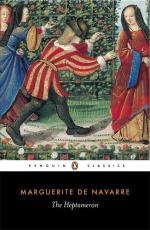As the young King of Navarre had spent a part of his youth at the French Court, he was well known to Margaret, who apparently had a secret fancy for him. He was in his twenty-fourth year, prepossessing, and extremely brave. (1) There was certainly a great disproportion of age between him and Margaret, but this must have served to increase rather than attenuate her passion. She herself was already thirty-five, and judging by a portrait executed about this period, (2) in which she is represented in mourning for the Duke of Alencon, with a long veil falling from her cap, her personal appearance was scarcely prepossessing.
The proposed alliance met with the approval of Francis, who behaved generously to his sister. He granted her for life the enjoyment of the duchies of Alencon and Berry, with the counties of Armagnac and Le Perche and several other lordships. Finally, the marriage was celebrated on January 24th, 1527, at St. Germain-en-Laye, where, as Sauvai records, “there were jousts, tourneying, and great triumph for the space of eight days or thereabouts.” (3)
1 He was born at Sanguesa,
April 1503, and became King of
Navarre in 1517.
2 This portrait is
at the Bibliotheque Nationale in the
Recueil de Portraits
au crayon by Clouet, Dumonstier, &c.
(fol. 88).
3 Antiquites de Paris, vol. ii. p. 688.
III.
The retirement of King Henry to Beam—Margaret’s intercourse with her brother—The inscription at Chambord—Margaret’s adventure with Bonnivet—Margaret’s relations with her husband—Her opinions upon love and conjugal fidelity—Her confinements and her children—The Court in Beam and the refugee Reformers—Margaret’s first poems—Her devices, pastorals, and mysteries—The embellishment of Pau—Margaret at table and in her study—Reforms and improvements in Beam—Works of defence at Navarreinx—Scheme of refortifying Sauveterre.
Some historians have stated that in wedding his sister to Henry d’Albret, Francis pledged himself to compel Charles V. to surrender his brother-in-law’s kingdom of Navarre. This, however, was but a political project, of which no deed guaranteed the execution. Francis no doubt promised Margaret to make every effort to further the restitution, and she constantly reminded him of his promise, as is shown by several of her letters. However, political exigencies prevented Francis from carrying out his plans, and in a diplomatic document concerning the release of the children whom Charles held as hostages the following clause occurs: “Item, the said Lord King promises not to help or favour the King of Navarre (although he has married his only and dear beloved sister) in reconquering his kingdom.” (1)




